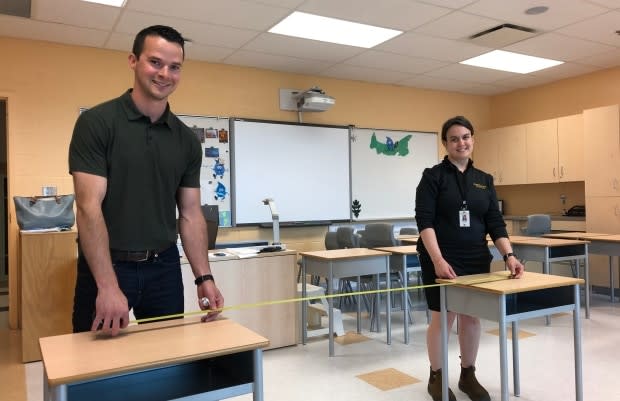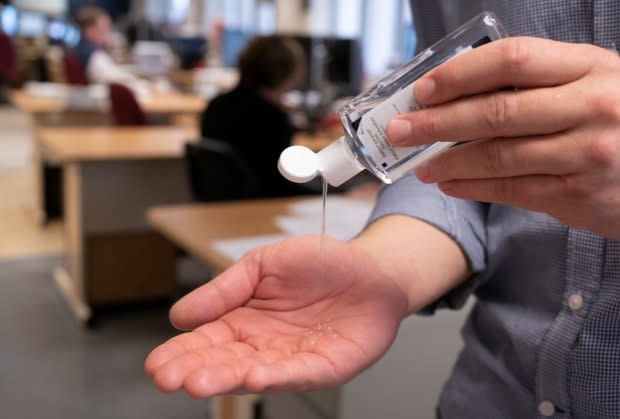P.E.I. return to schools relies heavily on grouping students, enhanced cleaning

Students returning to school buildings on P.E.I. this fall will not be able to mix as freely with their schoolmates as they have in the past, according to the province's COVID-19 guidelines.
The Public Schools Branch released its planned rules for the Sept. 8 return to school early Wednesday afternoon. Premier Dennis King, Education Minister Brad Trivers and Chief Public Health Officer Dr. Heather Morrison gave a news conference about the plan shortly afterward.
"The health of our Island children is our top priority," King said. "We know that we can make this happen safely and successfully."
The provincial document was posted online along with a long list of frequently asked questions about the new guidelines, accessible at this link.
Trivers said all schools will use the guidelines to prepare more specific plans depending on the layout of their facilities and needs of their students.
"Really, it's the operational plans at every school that are going to complete that last piece of the puzzle that will set parents at ease," he said.
The education minister said six of the plans have been completed, with the rest coming at the end of next week.
"The principals are all working hard. They're in between contracts ... so they've come back," he said.
"We've been able to work with the unions to make that happen."
Students and staff to form 'cohorts'
All 62 P.E.I. public schools were shut down in mid-March because of the COVID-19 pandemic. Distance learning continued, but the return to school plan acknowledges that learning is best when it happens at school.
Trivers said officials will have to get creative in delivering programming, but that students will be able to pick courses from throughout the curriculum.
"That includes music, physical education, industrial arts and electives," he said.
At the centre of the document will be the division of schools into "cohorts" of students and staff, with efforts being made to minimize contact between different groups.

The province's online material defines "cohort" as "a group of students and staff who stay together, and remain isolated from other cohorts. Your cohort may depend on the size of your classroom, or school."
The groups will help minimize spread within a school should an outbreak occur and make contact tracing easier.
Schools will make efforts to contain cohorts within a particular area of the building. Times when students are moving around — such as at arrival and departure, and on recess and lunch breaks — will be staggered to reduce contact between the cohorts. The groups will also use separate entrances to the building if possible.
The PSB document notes that this requirement could cause delays at the beginning and the end of each school day.
"We've allowed for additional staff resources as needed, you know, for example, we're going to make sure that there's a full-time admin at every school," Trivers said.
"The office administrators are often the ones that are that point of contact between the school and the parents and that sort of thing."
Physical distancing
Students will be required to bring a non-medical mask to school, but the wearing of that mask is only strongly recommended, not required.

In particular, it is strongly recommended that students wear masks in situations where physical distancing cannot be maintained, such as during class changes at high schools and on school buses.
This recommendation is considered more important for students in grades 7 to 12.
As much as possible, schools will be configured to promote physical distancing, with more space between desks, hallways divided into directional lanes, and playgrounds divided for use by different cohorts.
Careful attendance records will be a part of preparing for any necessary contact tracing.
Cleaning changes
Protocols for enhanced cleaning of schools and school buses are also outlined in the document.

School buses will be cleaned and sanitized after morning and afternoon runs. Classrooms will be cleaned daily, with particular attention to bathrooms as well as regularly touched surfaces, such as door handles, handrails and light switches.
In cases where classrooms are shared, such as in high schools, students will be provided with cleaning materials to wipe down their own personal areas before leaving class.
Custodial staff are being trained in new cleaning and sanitizing practices. Principals may apply for more cleaning staff if they believe it is required.
Hand hygiene will also be emphasized, with regular handwashing breaks scheduled, and hand sanitizer available in strategic locations.
"As parents, we can help by getting our children used to wearing masks, washing their hands and keeping their hands to themselves and not sharing toys," said Morrison.
"We can have conversations with our children about why these public health measures are important."
Any materials that are shared, such as sports equipment or books, will be sanitized immediately afterward if possible or otherwise quarantined for 72 hours.
School buses
Getting students to and from school will be a particular challenge.

Given the resources available, in terms of drivers and buses, only so much physical distancing on school buses will be possible.
The PSB will encourage parents and students to consider other forms of transportation in an effort to reduce the number of students it is transporting.
"The goal is still to reduce ridership on buses ... that's where there is potential of spread through a larger group," Trivers said.
"We are still asking parents if they're willing and able to rearrange alternate methods to get their children to school, and I personally would like to see them walk or bike and do that in an active way, if possible."
All eligible students will be allowed on buses. Riding a bike to school in the fall will not mean giving up your seat on the bus for the winter.
Extra-curricular
After-school sports and other activities will be paused at the beginning of the school year.
The startup of these activities will be at the discretion of individual schools in consultation with the PSB, taking Chief Public Health Office (CPHO) guidelines into consideration.
Physical education classes will go ahead under guidelines produced by the Physical Education and Health Association of Canada:
No use of equipment or minimal use of equipment.
Students will be expected to have gym footwear, but change rooms will not be used.
Classes should be held outdoors as much as possible.
Schools will continue to welcome community groups after hours.
Community groups will have to provide an operational plan which clearly outlines how the group intends to operate while complying fully with the CPHO recommendations and guidelines.
More from CBC P.E.I.


